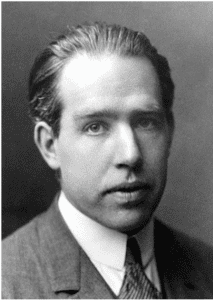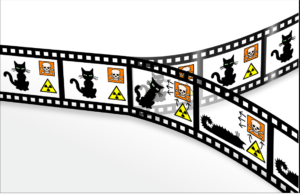The Copenhagen Interpretation of quantum mechanics is the original attempt by physicists to provide an explanation for the results of quantum experiments. When people say that “an electron is in more than one place at the same time” or that the “electron travels as a wave and is detected as a particle,” they are likely embracing the Copenhagen Interpretation. (These kinds of puzzling descriptions are, however, mischaracterizations of Copenhagen, as will be seen below.)
The Copenhagen Interpretation is, actually, a group of closely related interpretations. Here are a few of the key concepts common to interpretations grouped under the heading “Copenhagen.”
Wave-Particle Duality

According to the Copenhagen Interpretation, atomic and subatomic particles sometimes act like particles and sometimes act like waves. This is called “wave-particle duality.” An electron, for example, when detected, is in its localized particle form. But between detected positions, an electron is in its wave-like form. This form is described mathematically by an equation called a “wave function.”
In the 1920’s and ‘30’s, Niels Bohr led his students and colleagues in developing the Copenhagen Interpretation at his famous institute of quantum mechanics in Copenhagen. [Image source: Public Domain, Niels Bohr – Wikipedia]
One of the liabilities of the Copenhagen Interpretation is that it’s easy to mischaracterize. And that’s exactly what I’ve just done. Actually, the Copenhagen Interpretation says that we can’t know or say anything about the electron in-between detections. We should lapse into silence and simply point mutely to the equations. This is because we can’t observe the electron, even in principle, in-between detections, A detection, after all, requires observing.
Copenhagen insists, “Why should science address behavior which we can never, in principle, observe? Better to ignore it, Even better, say that it doesn’t even exist!” Niels Bohr is quoted as saying, “There is no quantum world. It is wrong to think that the task of physics is to find out how nature is. Physics concerns what we can say about nature.”
So, according to Copenhagen, we can say about the undetected electron, only that an equation called the “wave function” applies. Another approach is to say that “the wave state of the electron” is a metaphor, not a description of physical reality.

This animation of the Double Slit Experiment depicts the Copenhagen metaphor—that the quantum particle travels as a wave.
The wave function results in the wave interference pattern that electrons manifest in experiments like the Double Slit Experiment. In classical physics, a wave interference pattern means that a wave is being detected. But, to repeat the theme, in the Copenhagen Interpretation, the wave interference pattern means nothing about the nature of reality. All we can say is that a mathematical expression, the wave function, successfully predicts experimental results.
Probability Wave
Max Born, a co-founder of quantum mechanics and the Copenhagen Interpretation, held a view divergent from that of Niels Bohr. Born saw the wave function as describing a real wave. He called it a “probability wave,” and this term is still in use. Born reasoned that if calculating the wave function gives the probabilities of where the particle is likely to be detected, it must be describing the cause of the particle’s position. And if it causes something, it must be real.
However, Born was not able to pin down the exact nature of a “probability wave.” What is waving? How does it disappear from every point in the universe simultaneously at the moment the associated particle is detected? While it is common for physicists to use the term “probability wave,” its meaning is undefined to this day.
Interpretations That Reject Wave-Particle Duality
Wave-particle duality plays a different role in some of the other interpretations of quantum mechanics, for example, the Bohmian Interpretation. The Bohmian Interpretation was developed by French nobleman and physicist, Louis de Broglie (in the 1920’s) and American physicist, David Bohm (in the 1950’s and ‘60’s). It says that there is always a wave and always a particle. In the Double Slit Experiment, a real wave travels through both slits. It is formed by a new kind of energy called “quantum potential.” It guides the particle through one of the slits but not both. This interpretation is also called the “Guiding Wave” or “Pilot Wave Interpretation.”

While this brief description isn’t sufficient to give a clear picture of the Bohmian Interpretation. I hope that it serves to illustrate that Copenhagen is only one interpretation. I mention this because sometimes when quantum physics is taught, the Copenhagen Interpretation is presented as if it were one and the same as quantum physics. Instead, it is one of the many interpretations of the equations of quantum physics. In fact, there are over 20 interpretations under serious consideration by physicists.
Wave Function Collapse
In the original version of the Copenhagen Interpretation, the moment that quantum particles interact with a macroscopic object, they cease to follow quantum laws and become part of the macroscopic realm. This is wave function collapse. For example, when an electron hits a phosphorescent screen, it interacts with the phosphor to create a tiny spark. At that moment, it experiences wave function collapse. It collapses down from its wavelike form to its particle form. The spark marks the localized position where the electron acts as a particle. “Localized position” is a defining characteristic of a particle. Wave function collapse appears in this animation of the Double Slit Experiment.
In recent decades, many physicists have abandoned the idea that macroscopic objects are qualitatively different from quantum objects. Currently, most physicists believe that macroscopic objects follow quantum laws just as quantum objects do. Macroscopic objects do not have a special quality which allows them to collapse the wave function of quantum objects.
Instead, interaction with any bit of matter or energy collapses the wave function of a quantum object. Because macroscopic objects are made of many particles, they provide many more opportunities for interaction than subatomic particles. So, macroscopic objects are more likely to cause wave function collapse than a subatomic particle. This is a brief and very general statement of decoherence theory, which is frequently incorporated into the current understanding of the Copenhagen Interpretation. In this way, Copenhagen has evolved.
Interpretations That Reject Wave Function Collapse
Many interpretations of quantum mechanics reject the concept of wave function collapse. In the Bohmian Interpretation, for example, there is always a wave and always a particle. So, the wave does not collapse down to a particle.
The Many Worlds Interpretation also rejects the concept of wave function collapse. The Many Worlds Interpretation holds that the wave function describes all the positions that a real particle assumes, each position being in a different universe. There is never a shift between a wavy state, where the particle is not real, and a particle state, where it is real. The particle is always real in every position described by the wave function.

Branching universes in the Many Worlds Interpretation. Each time objects interact, they cause the universe to branch into two or more universes. The cartoon depicts the branching of two universes in the Schrodinger Cat Thought Experiment. When the atom in the experiment decays in one universe (and fails to decay in another branching universe), the cat dies in one universe (and lives in another universe). [Source: By Christian Schirm – Own work, CC0, File:Schroedingers cat film.svg]
Consciousness and the Collapse of the Wave Function
The hypothesis that consciousness causes the collapse of the wave function is a variation on the Copenhagen Interpretation. Rather than ascribing collapse to interaction with macroscopic objects, a few physicists have speculated that consciousness collapses the wave function. Among them was the premier mathematician of quantum mechanics of the 1920’s and ‘30’s, John Von Neumann, and a Nobel Laureate in physics, Eugene Wigner. Here is a brief description of this view as explained by the quantum physicist, Zvi Shreiber:
“The rules of quantum mechanics are correct but there is only one system which may be treated with quantum mechanics, namely the entire material world. There exist external observers which cannot be treated within quantum mechanics, namely human (and perhaps animal) minds, which perform measurements* on the brain causing wave function collapse.”**
Most, physicists, but not all, currently reject this view. The quantum physicist, Henry Stapp, is the most notable physicist who currently (2020) espouses it. A Wikipedia article on the Von Neumann-Wigner Interpretation describes the current state of the scientific consensus this way:
“A poll was conducted at a quantum mechanics conference in 2011 using 33 participants (including physicists, mathematicians, and philosophers). Researchers found that 6% of participants (2 of the 33) indicated that they believed the observer “plays a distinguished physical role (e.g., wave-function collapse by consciousness)”. This poll also states that 55% (18 of the 33) indicated that they believed the observer “plays a fundamental role in the application of the formalism but plays no distinguished physical role”. They also mention that ‘Popular accounts have sometimes suggested that the Copenhagen interpretation attributes such a role to consciousness. In our view, this is to misunderstand the Copenhagen interpretation.’ (bold font added) ***
It should be noted that Eugene Wigner, later in life, abandoned the idea that consciousness collapses the wave function. While the idea that consciousness collapses the wave function appears to be dead, some scientists are proposing that consciousness plays a related role in the creation of reality. For example, see the work of cognitive scientist Donald Hoffman and neuroscientist, Anil Seth. It’s possible that the understanding of consciousness and reality which underlies their line of thinking informed the views of some early quantum physicists like Wigner.
Lack of Realism
One of the surprising characteristics of the Copenhagen Interpretation is that it does not incorporate realism. Realism is the principle that the universe exists “out there” all the time independent of our minds and/or our actions. According to Copenhagen, particles do not have defined properties such as position until they interact with other particles. Quantum objects seem to exist in an ambiguous wavy state prior to wave function collapse.
Copenhagen posits that subatomic particles adopt a metaphorical wavy state (a “superposition”) prior to wave function collapse. This cartoon is doubly metaphorical. Due to decoherence, large objects like flowers do not take the form of superpositions. [Image source: David Chalmers and Kelvin McQueen, “Consciousness and the Collapse of the Wave Function” http://consc.net/slides/collapse.pdf]
As noted above, this wavy state is metaphorical rather than a description of physical reality. If you find this hard to grasp and confusing, join the club. The failure of Copenhagen to explain the physical reality which the wave function describes creates a vacuum which people try to fill with concepts like “probability wave,” “wave-like state” and other ambiguous, undefinable terms.
One of the major objections that Albert Einstein had to the Copenhagen Interpretation was that it conflicts with the principle of realism. He is famous for saying, “I like to think that the moon is there even when I’m not looking at it.”
Probabilistic Behavior and True Randomness
When doing the Double Slit Experiment, physicists shoot a particle, let’s say an electron, through slits in a barrier towards a detection screen. Physicists use the wave function to predict where the electron will land on the detection screen.
But the equation predicts only probabilities, not the position in which any particular electron will land. If the Double Slit Experiment is repeated numerous times, perhaps thousands of times, the results will reflect the probabilities of the wave function. For example, if the equation calculates a 50% probability for any particular position, 50% of electrons will be found to land in that position. However, physicists are unable to predict the position of any particular electron; the equation is silent on that question.
In the Copenhagen Interpretation, it’s considered that there is no prior cause of the position of any particular electron. This is called “acausality” or “true randomness” or “lack of determinism.” We have no equation which tells us the position of each particle. And we have no theoretical reason to believe that there is a cause for that particular position.
Some interpretations of quantum mechanics reject true randomness. The Bohmian Interpretation is among them. In the Bohmian Interpretation, infinitesimal differences in the initial positions and velocities of the particles account for differences in positions upon detection. And recall that the particle is present at the initial position, throughout its travel, and upon detection, always carried along by its guiding wave.
History and Current Status of the Copenhagen Interpretation
Bohr, Werner Heisenberg, and others who worked at Bohr’s physics institute in Copenhagen, came up with the Copenhagen Interpretation. Schrodinger and other quantum physicists didn’t fully buy into Bohr’s interpretation and created their own variations.
And variations have continued to develop over time. Many physicists now reject some of the original principles. These complications can make it confusing for today’s students, who must sift through statements of Copenhagen which some physicists never subscribed to or which many no longer subscribe to.
Copenhagen continues to be the interpretation taught in university courses and is sometimes called the “orthodox interpretation” or the “standard interpretation.” While a large fraction of physicists continue to rely on this interpretation, many others subscribe to other interpretations.
Footnotes
*”Measurement” has special implications in quantum mechanics as it changes the thing measured. “Measurement” means observation or detection. For more information, see this article on measurement.
**Zvi Schreiber, Masters of Science thesis, “The Nine Lives of Schrodinger’s Cat,” University of London, Oct. 1994. As quoted in Wikipedia, the “Von Neumann-Wigner Interpretation of Quantum Mechanics.”
***Quoted from Wikipedia article on the Von Neumann-Wigner Interpretation, which references: M. Schlosshauer; J. Koer; A. Zeilinger (2013). “A Snapshot of Foundational Attitudes Toward Quantum Mechanics”. Studies in History and Philosophy of Science Part B: Studies in History and Philosophy of Modern Physics. 44 (3): 222–230. arXiv:1301.1069. Bibcode:2013SHPMP..44..222S. doi:10.1016/j.shpsb.2013.04.004.
